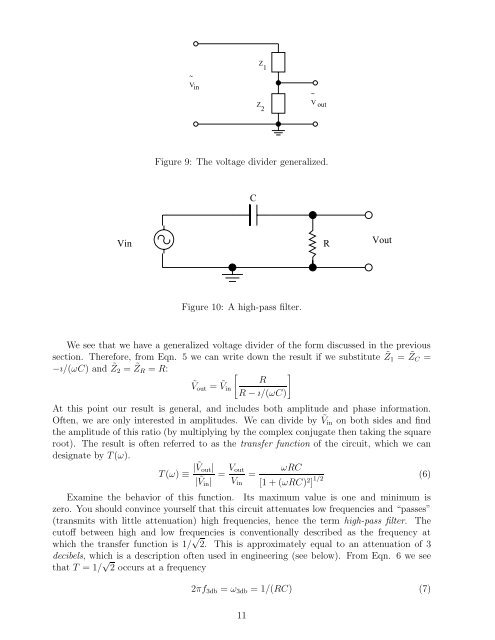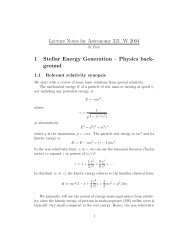Lecture Notes for Analog Electronics - The Electronic Universe ...
Lecture Notes for Analog Electronics - The Electronic Universe ...
Lecture Notes for Analog Electronics - The Electronic Universe ...
Create successful ePaper yourself
Turn your PDF publications into a flip-book with our unique Google optimized e-Paper software.
Vin<br />
~<br />
Vin Z 1<br />
Z 2<br />
~<br />
V out<br />
Figure 9: <strong>The</strong> voltage divider generalized.<br />
C<br />
Figure 10: A high-pass filter.<br />
R<br />
Vout<br />
We see that we have a generalized voltage divider of the <strong>for</strong>m discussed in the previous<br />
section. <strong>The</strong>re<strong>for</strong>e, from Eqn. 5 we can write down the result if we substitute ˜ Z1 = ˜ ZC =<br />
−ı/(ωC) and ˜ Z2= ˜ ZR=R:<br />
˜Vout = ˜ �<br />
�<br />
R<br />
Vin<br />
R − ı/(ωC)<br />
At this point our result is general, and includes both amplitude and phase in<strong>for</strong>mation.<br />
Often, we are only interested in amplitudes. We can divide by ˜ Vin on both sides and find<br />
the amplitude of this ratio (by multiplying by the complex conjugate then taking the square<br />
root). <strong>The</strong> result is often referred to as the transfer function of the circuit, which we can<br />
designate by T (ω).<br />
T (ω) ≡ | ˜ Vout|<br />
| ˜ Vin|<br />
= Vout<br />
Vin<br />
=<br />
ωRC<br />
[1 + (ωRC) 2 ] 1/2<br />
Examine the behavior of this function. Its maximum value is one and minimum is<br />
zero. You should convince yourself that this circuit attenuates low frequencies and “passes”<br />
(transmits with little attenuation) high frequencies, hence the term high-pass filter. <strong>The</strong><br />
cutoff between high and low frequencies is conventionally described as the frequency at<br />
which the transfer function is 1/ √ 2. This is approximately equal to an attenuation of 3<br />
decibels, which is a description often used in engineering (see below). From Eqn. 6 we see<br />
that T =1/ √ 2 occurs at a frequency<br />
(6)<br />
2πf3db = ω3db =1/(RC) (7)<br />
11













